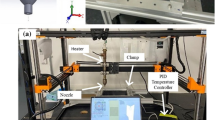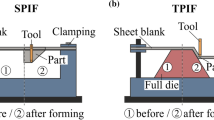Abstract
Advanced polymers offer at the present time concrete possibilities in reducing the product development time and production of prototypes and small series of sheet metal parts. However, the applicability of such materials requires different approaches in comparison to conventional materials for sheet metal forming dies. This paper presents investigation results dealing with tribological and tool design aspects for the use of polymeric materials in sheet metal forming. Friction and wear of sheets with different surface topologies have been investigated. A new test method for measuring polymer/sheet wear is presented. A coupled simulation model for the production of a test geometry aimed specifically at the investigation of die deformations and loads is presented. The behaviour of two polymeric materials by forming the test geometry has been simulated and the maximal loads and deformations during the process have been quantified. Simulation results have been subsequently validated in experimental testing.





















Similar content being viewed by others
References
Haller B (2002) Optimierung von Prozeßketten für die Herstellung von Prototyp-Blechumformwerkzeu-gen. PhD thesis, Institut für Umformtechnik, Uni-versität Stuttgart, ISBN 3-88355-312-3
de Souza JHC, Liewald M (2007) Applicability of polymeric materials for rapid tooling in sheet metal forming. In: IDDRG International Conference: 445–452
Hortig D (2003) Vom Design zum Blechbauteil—Proto-typteile für Fahrzeugkarrosserie. In 8, Umform-technisches Kolloquium Darmstadt, 195–201
de Souza JHC, Liewald M (2006) New design concept for deep drawing prototype tools. In: Euro-uRapid 2006, Frankfurt
Deiler G (2005) Untersuchungen zum Eignungsprofil polymerer Werkzeugwerkstoffe für das Tiefziehen von Feinblechen. PhD thesis, Universität Hannover, ISBN 3-936888-83-3
Colton JS, Park Y (2003) Sheet metal forming using polymer composite rapid prototype tooling. J Eng Mater Technol 125:247–255, July
Bay N (2006) Lubricant test methods for sheet metal forming. In: Proceedings of NORD-TRIB 2006 Conference, ISBN: 87-90416-19-8
Czichos H et al (1995) Advances in tribology: the materials point of view. In Wear 190:155–161
Briscoe E (1981) Wear of polymers: an essay on fundamental aspects. In: Tribology International, 231–243, February
Briscoe B, Sinha S (2005) Wear—materials, mechanism and practice, Chap 10: Tribology of polymeric solids and their composites. Wiley, ISBN: 978-0-470-01628-2
Zum Gahr K-H (1987) Microstructure and wear of materials. Elsevier, Amsterdam, ISBN 0-444-42754-6
Bellow DG, Viswanath S (1993) Case study—an analysis of wear of polymers. In Wear 162/164:1048–1053
Sinha SK et al (2007) Scratching of polymers—modeling abrasive wear. In Wear 262:1038–1047
Witthüser K-P (1980) Untersuchung von Prüfverfahren zur Beurteilung der Reibungsverhältnisse beim Tiefziehen. PhD Thesis, Universität Hannover
Woska R (1982) Einfluß ausgewählter Oberflächen-schichten auf das Reib-und Verschleißverhalten beim Tiefziehen. PhD Thesis, Technischen Hochschule Darmstadt
Frank C (1999) Kunststoff als Werkzeugwerkstoff für das Tiefziehen von Feinblech. PhD Thesis, Universität Hannover
Grautoff G (2001) Tiefziehwerkzeuge aus Kunststoff für Kleine und mittlere Blechteilserien aus Aluminium. PhD Thesis, Technisches Universität Darmstadt, ISBN 3-8265-8989-0
Alaoui MM (2005) Tiefziehwerkzeuge aus Kunststoff: Standzeiterhöhung durch Beimengung von speziellen Mikro-und Nanofüllstoffen. PhD Thesis, Technische Universität Clausthal, ISBN 3-925658-99-8
Behrens B-A, Schäfer F (2007) Verschleißberechnung bei Tiefziehwerkzeugen aus Kunststoff. 10. Jubiläums-Workshop “Simulation in der Umformtechnik”
Schulte S, Schulz-Marner SH (1997) Verschleißprüfstand für die Blechumformung. In: Bänder Bleche Rohre 9
Bartenev GM, Lavtrentev VV (1981) Friction and wear of polymers. Elsevier, Amsterdam, ISBN 0-444-42000-2
Wagner S (1996) 3D-Beschreibung der Oberflächenstrukturen von Feinblechen. PhD Thesis, Universität Stuttgart
Wagner S (2001) Optimizing friction between die and sheet metal. In: Second Global Symposium on Innovations in Materials Process and Manufacturing. TMS, New Orleans, February 12–15
Bartenev GM et al (1971) The actual contact area and friction properties of elastomers under frictional contact with solid surfaces. In Wear 18:439–447
LS-Dyna® Theoretical Manual, Livermore Software Technology Corporation, 1998
Author information
Authors and Affiliations
Corresponding author
Rights and permissions
About this article
Cite this article
Liewald, M., de Souza, J.H.C. New developments on the use of polymeric materials in sheet metal forming. Prod. Eng. Res. Devel. 2, 63–72 (2008). https://doi.org/10.1007/s11740-008-0077-5
Received:
Accepted:
Published:
Issue Date:
DOI: https://doi.org/10.1007/s11740-008-0077-5




